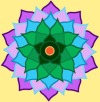Aurangâbâd, 15 January 2000
Temples in Caves and Temples of Rock
About thirty kilometres north of Aurangâbâd are the Ellora temple caves and rock temples. They were built during three periods. The Buddhist cave temples were carved 600‑800 AD, the Hindu 600-900 AD and the Jain 800‑1000AD. What an intriguing thought: “thousands of Monks of different religions chiselling temples and chapels out of the rock over a period of many hundreds of years, next to each other.”

Why here? Why this way? Was there competition, any fighting, or jealousy? Had they been guided by a “Higher Power” that has drawn them here, independent of their beliefs? Towards the end of the first millennium, Buddhism had declined in India. After the Buddhist monks had left, Hindu monks converted the largest Buddhist temple and dedicated it to Shiva.
Early Buddhist Temples
Our tour guide was Ram Pitambare. He told us how proud he was when he was chosen to show parts of his country and culture to Australian students of architecture and design. He promised us to give his best. He never stopped talking. His voice was very melodic, his expressions floral and perfect, ready to be printed. What an incredibly knowledgeable man he was, but ever so austere, so unapproachable.
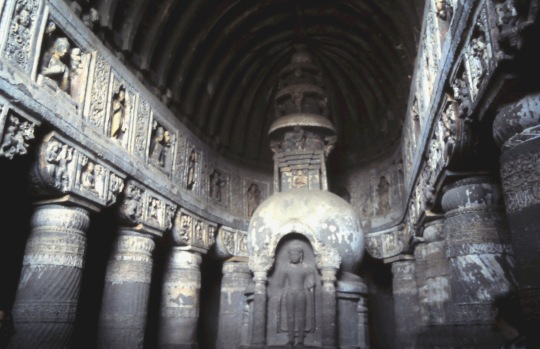
We started our ‘inspection’ with the early Buddhist temples, called chaitya meaning hall for meditation and teaching. They were carved in solid rock. Generally, a chaitya is a rectangular room with a central nave flanked by two aisles. The three sections were separated by lines of columns. Of architectural interest were the large capitals, which almost span the gap between the columns and highly decorated entablature.
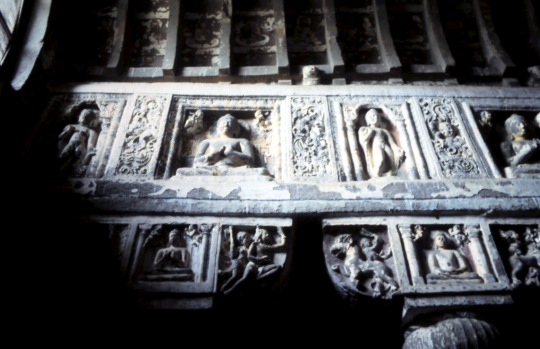
The rounded ceiling had been decorated with beam‑like ornamentations. I assumed the workers copied this from earlier the chaityas, which had been constructed from timber.
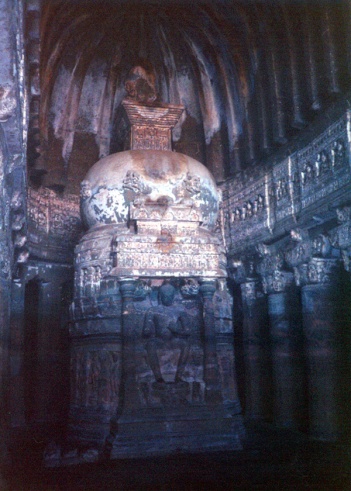
At its focal point in the apse was located the stupa as a symbol of reference to Buddha (worshippers seem to need them, even some gods prohibit them, specifically). A cube of about three meters formed its base, and it was covered with a three-quarter sphere or dome, looking not unlike the onion-shaped roof of a mosque. In early times its front was adorned with ornaments, called mandala; I talk more about it further down.
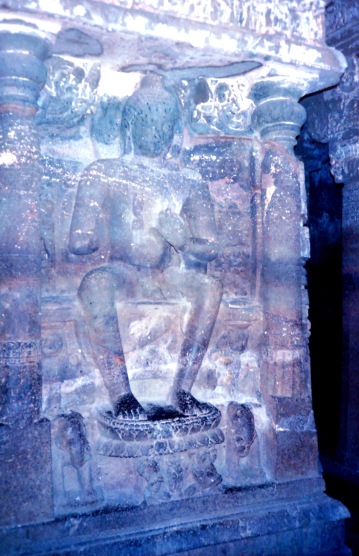
To keep up with fashion images of the meditating gurus (or Buddha) have been chiselled over these mandalas.
On top of the sphere was an arrangement looking somewhat like the stump of the upper end of a Greek column with its capital. Inside a stupa often relics were contained or more often sutra texts written on palm leaves, bark, or leaves of metal.
§
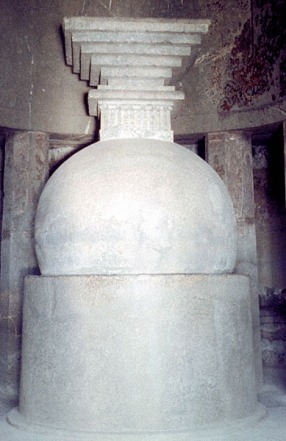
The early chaityas’ layout followed the Hinayana school of thinking, when Buddha’s presence was not shown through his image but only alluded to by a symbol also referred to in the shape of a mandala. Mandalas are round ornaments with often several axes of symmetry. They can be painted on ceilings, walls and floors, or be a chiselled or sculptured relief.
Tibetan Buddhist monks have the ritual of making mandalas from coloured sand. The largest I have seen was over two metres in diameter. For several days or weeks, monks would work day and night.
After the mandala is completed, the abbot swishes over it with something like a big feather duster. This teaches non‑attachment and about the transient nature of all things made by human beings.
Shamans around the world use mandalas as gateways into the spirit world. They apply them to travel between the worlds, for themselves or the spirits, mostly for healing, explaining omens or predicting the future. Immediately after the completed action, the mandala is destroyed, mainly to prevent evil spirits from crossing over into this world.
Towards the end of the period of Buddhism, popularity images of Buddha became trendy and even in this early chaitya, we found a stretched-out sleeping Buddha of five times human length carved into the wall of the left aisle.
One could regard this as a marketing trick: once a product is outdated, jazz it up and keep it attractive. After this early times, larger temples with a more open floor plan were built. The unfashionable chaitya style temples were degraded to storage rooms for food.
§
Once we were all inside the chaitya Ram closed the wooden door and chanted. What an experience. No one remained untouched.
§
I noticed that the chaityas were ignored by most of the visitors. They all aim for the more prominent temples, which are more impressive by their size.
As we moved along the long escarpment, we arrived at the Hindu temples. When we approached this area, we were assaulted continuously by street merchants. Specifically me they called: “Chádya.” I found it a bit annoying.
Losing my Indian-temper-conditioning, I asked Ram what this word means. He explained: “They call you uncle. It is an expression of respect because you are older.” There was really no reason to be annoyed, or was there? They still pestered me with all respect, trying to flog off their merchandise and I still didn’t like it.
Hindu Temples

The Hindu cave temples were huge. Some of the caves have three storeys, some open into a square courtyard with ceremonial areas and sculptures in them. One could imagine how worshippers would sit in the galleries watching the religious proceedings of the monks.
There was a different style where the temple was free-standing but still carved out of the solid rock. For this, they first had to free a somewhat cubical section of about ten meters more extensive than the block for the temple. Then they would shape the outside and the inside.
I was amazed when considering the builders understanding of the construction and stability of buildings. The inside had to line up with the outside. And there was no second attempt. Once it was chipped off, you cannot put it back again.
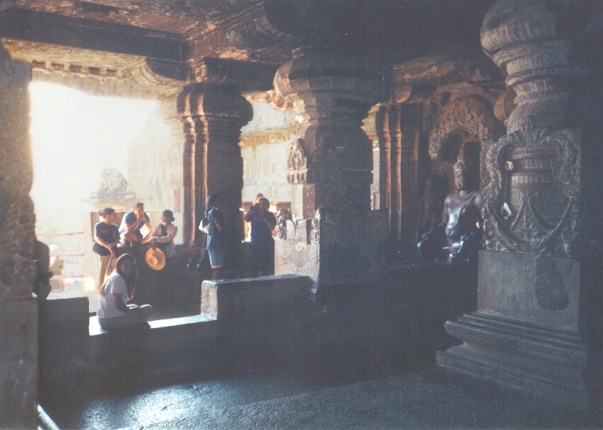
The biggest was the Kailasa temple. It represents Mt. Kailasa, Shiva’s home in the Himalayas. The space excavated was 81m long, 47m deep into the rock and 33m high where it faced the mountain. Leaving the temple behind, they removed 200 000 tonnes of rock. You need lots of time and lots of monks. It was big.
Interestingly, the newer temples were all Jain, and they were the smallest. Jain is the oldest form of Indian religion, but not much is left of its original leadership. In days of old, people had no need for building temples. When they wanted to worship their gods, they went on pilgrimages to the holy places.
§
New religions followed, and the influential and wealthy people joined them (because it was fashionable?), rather than the traditional Jain. They started building temples for their gods; why? They wanted to avoid dangerous and strenuous journeys (Would they no longer believe their gods would protect them on their pilgrimage?). They wanted their gods to live nearby for easy access, and they tried to tempt them with magnificent buildings.
Jain faded into the background and only the poor, the people in the country, followed this religion, another reason for the non‑existence of early Jain temples. Then a changeover happened.
Jain had always been the religion of the warriors. In the old days when there was a need for defence, tribes elected warriors for this task of high honour. Receiving this respect was appreciation enough for the dangers they had to face, including death.
When the time of larger states arrived, rulers could not defend their property any longer just with locals. They needed help. And another aspect of war evolved: it was no longer restricted to defence but also to attack and occupy other countries.
Soldiering became a paid job, and the profession of mercenary evolved. Therefore, warriors got richer. The generals of hired armies received land for their services and became rulers themselves. In their new position, they could build temples, and they outperformed all others.
Today, Jain presents itself very opulent; it has become the religion of the upper class in India; most millionaires belong to it. What an amazing change.
Meeting a Goddess
Back to the rock temples. At one stage, I ventured off on my own, when suddenly, I felt a mysterious calling. I was drawn towards the smallest Jain temple; the last in a row of many and the youngest.

Through a narrow door way, I entered into a small courtyard which was dominated by an elephant statue, demanding the visitor to walk around it before entering into the temple’s prayer hall. Hidden away, in a corner of this hall was a narrow staircase taking me down to a room with a low ceiling, meaning I had to pull in my head. It took a while for my eyes to adjust to the meagre light.
On its back wall, I noticed a statue of a woman, a goddess? She had called me into her boudoir, how else could I have found her?
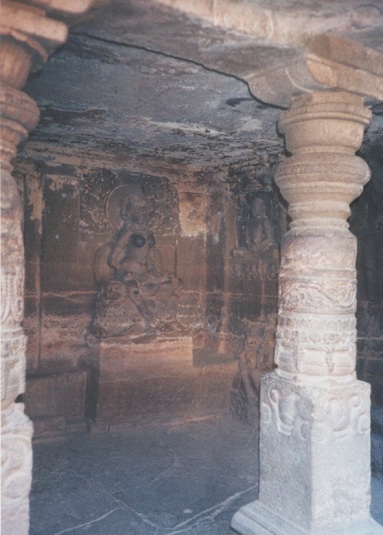
Casually, she sat on the back of a lion. Wearing only a tasselled sarong and adorned with necklaces, she generously presented her ball-shaped high breasts; “moon-shaped” is the Indian word for it. And we smiled.
Returning to the group, I found them halfway to “our” temple. It had been on route of your tour. A short while later, we met again. I was glad that we had our private time, now the room was filled with giggles. Ram, our tour guide, formally introduced us. Her name was Parvati, Shiva’s favourite consort and the lion is one of Shiva’s reincarnations and his Vahana (his vehicle).
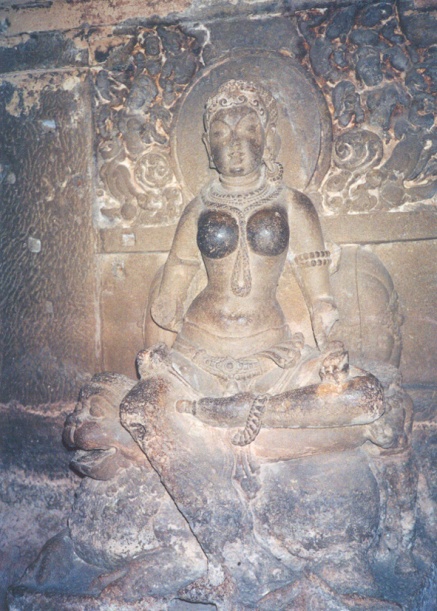
He told us, this was the best sculpture of her. I recalled she was made from matt dark granite and only her breasts being distinctly shiny. How many desiring hands must have caressed them to attain such sheen?
Not hands of man but the hands of thousands of devoted women, who rubbed them passionately and were praying for prolonging the youthful appearance of their own bodies and to be desired. I also remembered my surprise when I noticed, she had no nipples. Why? … Buffed away.
Ω
Aurangâbâd, Saturday, 15 January 2000
published: 18 October 2015
